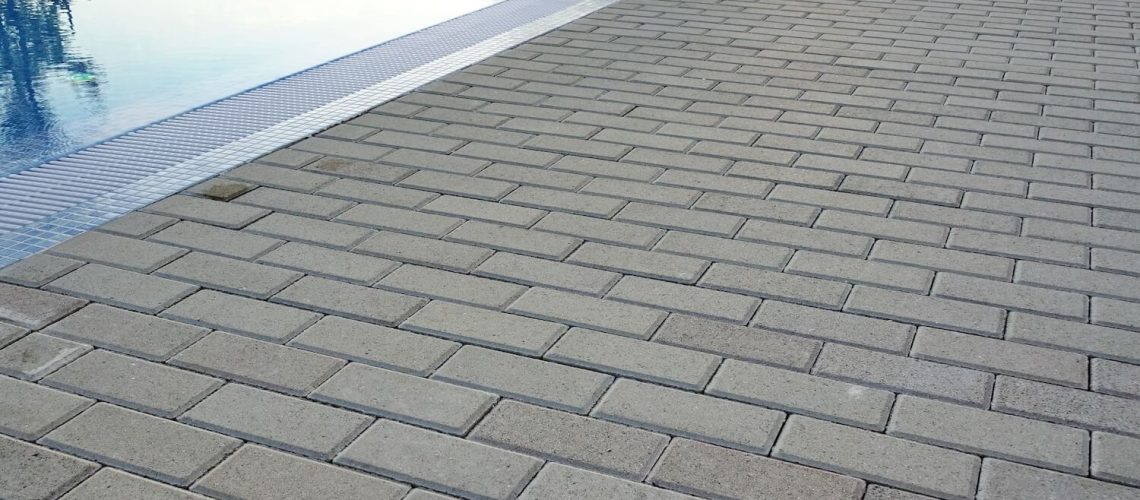When summer rolls around, there’s nothing better than diving into a sparkling pool, soaking up the sun, and hosting backyard barbecues with friends and family. Your pool area becomes the centerpiece of fun, relaxation, and memory-making. But it’s also one of the most accident-prone zones in your home—especially if your pool deck isn’t built for safety.
Slippery surfaces, standing water, and uneven terrain can quickly turn your sunny sanctuary into a danger zone. Fortunately, there’s a stylish, durable, and highly effective solution: paver installation.
Pool deck pavers don’t just make your space look fantastic—they offer crucial safety features that help prevent slips, improve drainage, and withstand the elements. When installed professionally, they become a long-lasting investment in both beauty and protection.
In this in-depth guide, we’ll cover everything you need to know about how pavers keep your pool deck safe and dry, the different materials available, the importance of professional installation, and why now is the perfect time to upgrade for a slip-free summer.
Why Pool Deck Safety Is So Important
Pavers are increasingly becoming the go-to choice for pool decks, and for good reason. While aesthetics and durability are major considerations, safety should be your top priority when choosing materials for your pool deck. Pavers offer a range of safety features that make them stand out compared to other materials commonly used for pool areas. Let’s dive deeper into why pavers are the safer choice for your pool deck.
1. Slip-Resistant Surface Texture
One of the primary safety advantages of pavers is their slip-resistant texture. Wet surfaces around a pool are a given, and water splashing onto the deck is unavoidable. However, many common pool deck materials, such as smooth concrete or tile, can become dangerously slippery when wet. Pavers, on the other hand, typically have a more textured or rough surface, which provides enhanced traction, even when wet.
The irregularities in paver materials—whether made from concrete, natural stone, or brick—help to grip shoes and bare feet, reducing the likelihood of slipping and falling. Materials like tumbled stone, travertine, and slate are particularly known for their ability to offer superior traction while maintaining a stylish look.
By choosing pavers for your pool deck, you create a walking surface that reduces the risk of accidents and enhances safety, even during pool parties when the deck is frequently wet.
2. Excellent Draining Capabilities
Another crucial safety feature of pavers is their exceptional drainage properties. Standing water on a pool deck can create serious hazards. Pooled water not only increases the chance of slipping but can also cause surface damage over time, resulting in cracks and uneven surfaces that present tripping hazards.
When properly installed, pavers promote excellent water drainage through their jointed construction. The gaps between individual pavers allow water to drain through to the ground below, preventing large puddles from forming. Furthermore, professional paver installation includes the use of a permeable base and polymeric sand to help manage water runoff, ensuring that water doesn’t collect on the surface.
This drainage system allows water to flow away from the pool area quickly, keeping your pool deck dry, reducing slip hazards, and preventing moisture from accumulating and causing further damage.
In addition, the drainage ability of pavers can help reduce the chances of mildew, moss, or algae growth, all of which can contribute to the slipperiness of pool areas. A dry surface is a safer surface.
3. Cool Underfoot, Even on Hot Days
When the summer heat hits, the surface of your pool deck can become unbearably hot, especially if you’re using materials like poured concrete, stamped concrete, or even some tiles. Bare feet can quickly become scorched on these materials, causing discomfort, burns, or accidental falls.
Pavers, particularly light-colored or natural stone pavers such as travertine or limestone, are more adept at staying cool to the touch. The surface of these pavers reflects sunlight rather than absorbing it, keeping the area comfortable even on the hottest days. As a result, you’ll be able to enjoy your pool area without the risk of painful burns on your feet—perfect for families with young children or elderly visitors.
Additionally, cooler pool deck surfaces make it more pleasant to walk, run, or play on the deck without having to constantly worry about the ground temperature.
4. Flexibility That Prevents Cracking
When it comes to durability, pavers hold an edge over traditional poured concrete or other solid materials. Poured concrete, while strong, can be susceptible to cracking over time, especially in regions that experience temperature fluctuations or freeze-thaw cycles. Concrete cracks can form due to pressure, impact, or settling, and these cracks are not just unsightly—they create dangerous tripping hazards.
On the other hand, pavers are designed to work together as individual units. When installed professionally, pavers allow for slight movement between the stones, which helps prevent cracking or breaking. If one paver does become damaged or cracked (e.g., due to an impact or settling), it can be easily replaced without disrupting the entire surface.
This flexibility makes pavers more durable than traditional materials, which contributes to a safer and more stable surface for your pool area.
5. Increased Stability and No Shifting Underfoot
Many pool decks can experience shifting or settling over time due to changes in temperature, soil movement, or water flow. This settling can cause the surface to become uneven, which presents a serious tripping hazard. While materials like poured concrete can crack and shift, pavers are laid over a carefully prepared base and compacted for stability, reducing the risk of shifting.
Moreover, paver stones are designed to lock into place, preventing them from moving independently. Even if a small amount of shifting occurs, individual pavers can be adjusted without affecting the overall integrity of the surface. This ensures that your pool deck remains stable and level, offering a safe walking surface for years to come.
6. Long-Lasting Durability & Low Maintenance
One of the safety advantages of pavers is their long-lasting durability. Unlike other materials, pavers do not require constant repairs or resurfacing to remain safe and functional. Traditional concrete or tiles can degrade over time, becoming cracked or loose, which may lead to uneven surfaces or dangerous spots on your pool deck.
Since pavers are incredibly durable and resistant to cracking, chipping, or warping, your pool deck will maintain its safety features without needing frequent upkeep. In fact, the occasional cleaning and resealing of your paver deck are usually all that’s required to keep it looking and performing like new. This low-maintenance quality contributes to the overall safety of the area—when there’s less chance for degradation or wear, the risk of accidents decreases.
Pavers vs. Other Pool Deck Materials
To fully appreciate the safety of pavers, it’s helpful to compare them to other common materials:
| Material | Slip Resistance | Drainage | Temperature | Maintenance | Durability |
|---|---|---|---|---|---|
| Pavers | High | Excellent | Cool to Medium | Low | High |
| Poured Concrete | Low to Medium | Poor | Hot | Medium | Medium |
| Stamped Concrete | Medium | Poor | Hot | Medium | Medium |
| Ceramic Tile | Very Low | Poor | Hot | High | Low |
| Wood Decking | Low | Poor | Medium | High | Low to Medium |
From this comparison, it’s clear that pavers lead the way in overall pool deck safety, particularly in terms of slip resistance and drainage—two of the most important factors in preventing poolside injuries.
How Professional Installation Maximizes Safety
While pavers offer built-in benefits, they only live up to their full potential when installed correctly. Professional paver installation is crucial for both safety and longevity.
Here’s what professional installers bring to the table:
1. Proper Grading & Slope
Water must flow away from the pool and the house. Professionals understand how to grade the base layer of the paver installation so that water runs off efficiently—minimizing puddles and reducing hydrostatic pressure that can damage the pool structure over time.
2. Solid Sub-Base for Stability
Professionals build a compacted sub-base using crushed stone and gravel to provide a solid foundation. This helps prevent shifting, settling, or the formation of low spots that can collect water and become slippery.
3. Edge Restraints
Strong edge restraints prevent the pavers from drifting apart over time, ensuring a level, unified surface without gaps or misalignments that could cause trips and falls.
4. Polymeric Sand for Joints
A key safety feature of professional installations is the use of polymeric sand between the joints. This special sand hardens when wet, locking pavers in place while still allowing for water drainage. It prevents weed growth and minimizes joint erosion that could lead to loose or unstable pavers.
5. Custom Design Integration
Professionals can incorporate features like:
- Slip-resistant border tiles
- Contrasting patterns to mark steps or edges
- Integrated drainage systems and channels
- Accessible zones for users with limited mobility
These details matter when it comes to reducing risks and creating a pool deck that’s both beautiful and highly functional.
6. Non-Slip Sealers & Finishes
Professionals can recommend and apply non-slip sealers that enhance surface grip without affecting the aesthetics of your pavers. These are particularly helpful for porcelain or smoother stone types.
Design Options that Improve Safety & Functionality
Safety doesn’t mean sacrificing style. Pavers allow you to blend design and security beautifully.
Color Contrast
Use darker or lighter shades around the pool edge or on stairs to make transitions visible. This visual cue helps prevent missteps and alerts users to elevation changes.
Border Definition
Define lounging areas, dining spaces, and walking paths using different shapes or patterns of pavers. This organizes foot traffic and reduces crowding near the pool’s edge.
Slip-Resistant Stone Choices
Some paver materials are naturally better at resisting slips. Top safe options include:
- Travertine – porous and cool to the touch
- Slate – textured and durable
- Concrete pavers with non-slip textures
- Granite – strong, slip-resistant, and luxurious
- Tumbled stone – naturally irregular and high-traction
A professional installer can help you match material and finish to your safety needs and climate.
Why Now Is the Perfect Time to Install Pool Deck Pavers
If your current pool deck is outdated, cracked, or slick, there’s no better time to upgrade than before summer hits full swing. A professionally installed paver deck can be completed in as little as one to two weeks depending on the size and complexity of your space.
Benefits of acting now include:
- Beating the heat and peak season pricing
- Having your pool area ready for summer parties
- Minimizing liability before hosting guests
- Adding lasting value to your home
Final Thoughts: Enjoy a Safer, More Stylish Summer
Your pool deck should be an inviting place to relax, entertain, and let your kids splash around without worry. Pavers provide the ideal combination of form and function—offering the traction, drainage, and flexibility needed to reduce risk and boost enjoyment.
But remember: it’s not just about the paver you choose—it’s how it’s installed. A professionally designed and installed paver pool deck ensures that every detail is addressed, from slope and surface texture to drainage and design flow.
So, whether you’re renovating an aging pool area or designing a new one from scratch, make the safe, smart, and stylish choice: pool deck pavers.
Ready to make your pool area safe, beautiful, and summer-ready? Contact Sequoia Stonescapes, a trusted professional paver installer, today and start planning the ultimate slip-free summer retreat.

